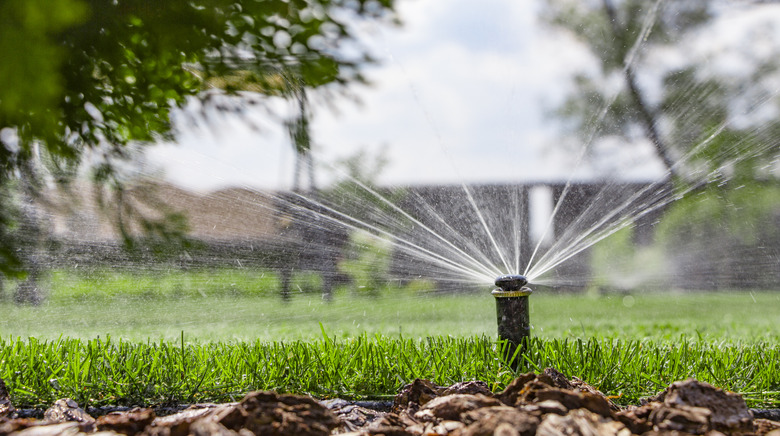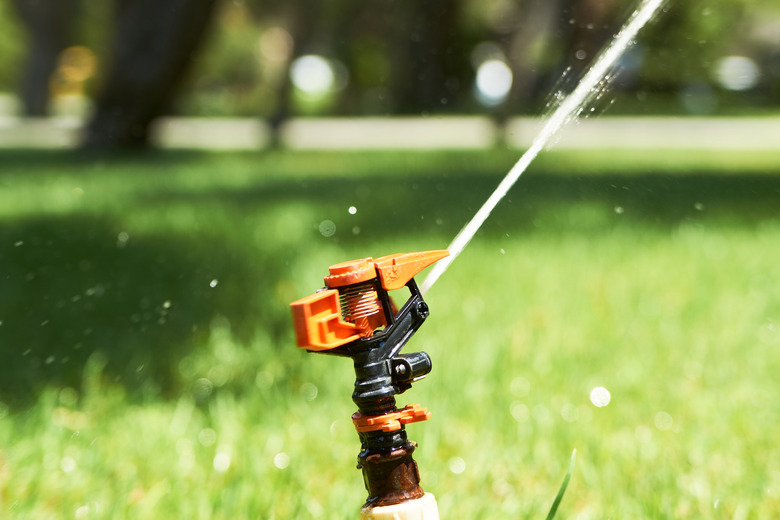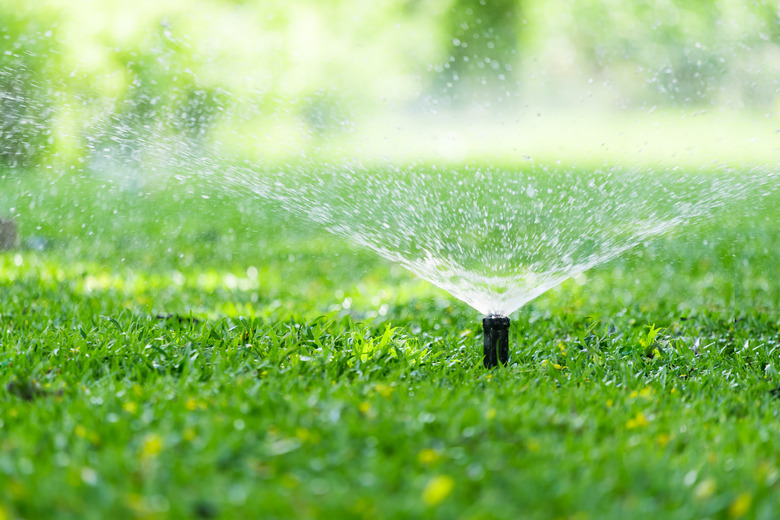Best Types Of Sprinkler Heads And Nozzles
We may receive a commission on purchases made from links.
When choosing from the myriad types of sprinkler heads available for your automatic sprinkler system, you'll be examining the following characteristics: spray pattern, spray distance, water pressure needs and water usage (including potential wastage). Some types of sprinkler heads cover large areas, so you don't need many, while others with a shorter range water more accurately. In general, the best type of sprinkler head or nozzle for a particular application is the one that works.
As you rummage through the store shelves or search for sprinkler heads online, you'll come across several brand names, and it's a good idea to stick with one brand for all of your sprinkler head needs. Some manufacturers, such as Rain Bird, Orbit, Hunter and Toro, have been around for a long time and are well-known to consumers. Others, such as Irritrol and Weathermatic, are probably better known to contractors. All make quality products, but it doesn't hurt to spend some time on the websites of a few manufacturers to compare features.
Different Types of Sprinkler Heads
Different Types of Sprinkler Heads
In a nutshell, there are two types of sprinkler heads for an automatic lawn and garden irrigation system: those that rotate and those that don't. The ones that don't are called fixed spray heads, and while most are built to pop up from the ground, some are designed to stay above ground. These so-called "shrub sprayers" can get in the way of the lawn mower and are best used for watering gardens. When you need to water roots, you can replace the spray nozzle on a fixed spray head, which screws on and off, with a bubbler, which streams or gushes water over a small area rather than spraying it over a large one.
Rotating sprinkler heads, which you can find on a pop-up sprinkler or an above-ground one, typically deliver water in a steady stream like a garden hose nozzle on the jet setting, and the head rotates through a preset arc. Gear-driven rotors include a water-pressure-powered turbine that operates the gears that rotate the head, while impact rotary sprinklers rely on the momentum developed by a loosely fitting impact arm to rotate.
Some fixed spray heads have an adjustable spray pattern, but many don't, and if you want to adjust the arc, you have to replace the nozzle. Most gear-driven and impact rotors have adjustments for both spray distance and spray arc, which makes them adaptable for a wide variety of situations. The best spray heads allow you to adjust the spray between a steady, far-reaching stream and a more diffuse spray with a shorter reach capable of watering closer areas.
Hunter Industries has introduced a third option, the MP rotator, which combines the benefits of fixed spray heads and rotating ones. It has a nozzle similar to that of a fixed spray head, but the nozzle rotates, providing more complete coverage with less water, so it's also known as a high-efficiency nozzle. An MP rotator uses approximately 30 percent less water than a conventional nozzle, which is a boon for people living in arid climates, and it sprays water in streams less likely to be dispersed by the wind and wasted than the diffuse emissions from conventional fixed spray heads.
Measure Water Pressure and Flow Rate
Measure Water Pressure and Flow Rate
When designing a sprinkler system, it's important to know the water pressure and flow rate of the water supply. You don't want to overload the sprinkler network and get insufficient flow from the sprinklers, or your grass won't get watered. You can measure pressure by attaching a pressure gauge to an outdoor spigot; and to measure flow rate, time how long it takes for the spigot to fill a bucket with a known volume when fully open.
Fixed spray heads typically operate at full capacity at 20 to 30 pounds per square inch (PSI), gear-driven rotors need from 25 to 35 PSI and impact rotors, which have the longest range of all sprinklers, usually need 40 PSI. Residential water pressure is usually somewhere between 50 and 60 PSI, but keep in mind that pressure is lost in the pipes, so the pressure at the sprinkler heads can be reduced by 10 PSI or more. You may find that after subtracting 10 PSI from the house pressure, the pressure at the sprinkler heads is less than 40 PSI; and if so, you should avoid using impact sprinklers and rely on gear-driven rotors and fixed spray heads.
The flow rate of a sprinkler head depends on the nozzle size and pressure, and your goal is to completely water each zone in the sprinkler system without exceeding the supply flow rate. This can be an issue especially when using impact sprinklers that distribute a lot of water, but you can avoid problems by choosing a model with an adjustable flow rate, such as the Rain Bird 25PJDAC Brass Impact Sprinkler.
Features of Top-Notch Sprinkler Heads
Features of Top-Notch Sprinkler Heads
Before you fill your yard with bargain sprinklers, you might want to consider some important features that you can get for just a few more dollars. For example, if you're looking for a pop-up sprinkler, make sure it has a spring to retract it. There are pop-up sprinklers that rely on gravity, and they commonly get stuck when partially retracted, allowing you to accidentally trim off the spray nozzle with your lawn mower. Stick to pop-ups with risers measuring 3 inches or more; the sprinkler needs at least that much height to get above the grass.
Another feature for which to look in a pop-up sprinkler is a rubber seal around the riser stem. It prevents the sprinkler from leaking and keeps dirt out of the sprinkler housing. If you don't see one, unscrew the nozzle carefully because it might be spring-loaded and look inside because it's sometimes recessed in the housing. Avoid sprinklers with can-style housings; when the sprinkler pops up, the housing can easily collect dirt.
Spray and rotary pop-up sprinklers are usually made of plastic, but impact sprinklers can be made of metal, and you should choose metal, specifically brass. The original impact sprinklers introduced by Rain Bird in 1933 were brass, and they have proven to be long-lasting and virtually corrosion-proof. If you're looking for a pop-up impact sprinkler, Orbit makes a brass one that has a range from 25 to 45 feet.
Best Sprinklers for Various Situations
Best Sprinklers for Various Situations
Some types of sprinklers are better than others for certain landscape configurations:
- Large lawn: Impact sprinklers are the best sprinkler heads for watering large areas. Because you can space them far apart (the spacing in feet is approximately equal to the water pressure in PSI), you need fewer of them, and they don't create a mist that disperses in the wind.
- Windy location: The spray from fixed sprinkler heads will just blow away from the intended area. Use rotary sprinklers in areas exposed to the wind.
- Long, narrow patches of grass: Rotary sprinklers are best. The arc can be adjusted to avoid watering sidewalks.
- Low pressure: If the pressure reading at the water supply is less than 50 PSI, which would mean the pressure at the sprinkler heads is less than 40 PSI, use gear-driven rotary sprinklers or spray heads, not impact sprinklers.
- Curved edges: If a lawn has curved edges, you can waste a lot of water trying to cover it with a rotary sprinkler. A better way is to install a zone of spray heads around the edge of the lawn, setting the arc to a half circle and pointing the spray toward the lawn. Install rotary sprinklers for the rest of the lawn on a separate zone.
- Small patch of lawn: A spray head with a full circle arc is usually the best sprinkler head for a small part of the lawn that is cut off from the main part by a garden or walkway.
References
- Dripdepot: Tips for Choosing the Correct Sprinkler Head for Your Lawn or Landscape
- Irrigation Tutorials: How to Pick the Best Sprinkler Head or Bubbler for Your Irrigation System
- Garden Helpful: 10 Best Lawn Sprinkler Heads – (2020 Reviews & Guide)
- Rain Bird: How Many Sprinklers Can Be Used Per Zone or Valve?


